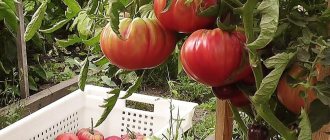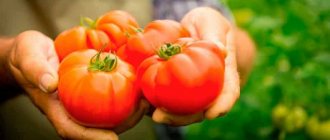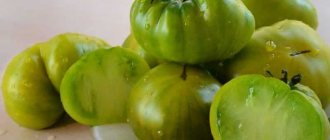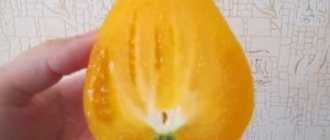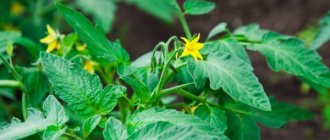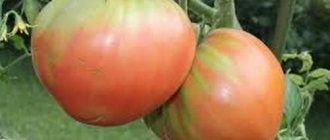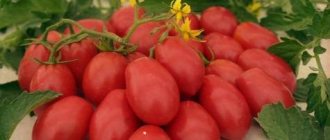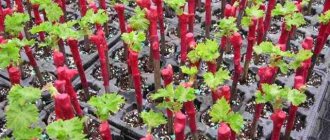Description of tomato
The originator of the variety is the Federal State Budgetary Institution "Vegetable Growing Research Institute" and LLC "Agro" Moscow region. On its basis, a group of authors, including: Maksimov S.V., Klimenko N.N., Ognev V.V., Kostenko A.N., developed a tomato variety worthy of admiration for its taste. Varietal testing took place over three years and in 2007 “Pink Flamingo” was included in the register of breeding achievements. The variety is recommended for cultivation as a salad variety only in the North Caucasus region.
However, over the more than ten-year history of its existence, the variety has managed to spread throughout the country. It did not take root everywhere, but it conquered some. The southern regions appreciated it, but the northerners had to abandon it.
Description of the bush
“Pink Flamingo” is a determinate variety. Its bushes do not exceed 60 cm in height. The fruits are not particularly large, so the formation is carried out in two shoots. Where the soils are very fertile and vegetable growers make special efforts to fertilize, three shoots are formed. The variety can withstand this load well.
The leaves are medium sized, classic tomato type, green. Inflorescences are simple with articulation. A bush with fully ripened fruits looks very beautiful. It looks like a Christmas tree, hung with identical pink balls.
Description of fruits
At first glance, ripe tomatoes of the “Pink Flamingo” variety look like small pink apples. Upon examination, slight ribbing can be detected. After setting and during the growth period, the fruits are rich green in color with a dark color in the stalk area.
During the ripening process, the stain resolves, becomes lighter and acquires a pink color. This color is not like crimson. Muted colors fill it exclusively with pink shades. Reviews indicate that color very much depends on the place of cultivation. Bright sunlight saturates the fruits with pink color faster and more intensely, and in the shade the colors are paler.
The average weight of tomatoes is about 100 g.
When cut, 4 to 6 seed chambers are clearly visible. There are no voids. A few seeds are found in the pulp of the fruit. The fruit is good both outside and inside. On the market counter this tomato looks like a mountain where all the tomatoes are:
- pink;
- the same;
- round.
Once they have bought such fruits and tried them, buyers will continue to give preference only to this tomato.
The description of taste and chemical composition deserves special attention. When evaluating the fruit, dry matter was determined. His numbers are 5.6-6.7%. They indicate that such a tomato will not be watery under any conditions.
The sugar content in “Pink Flamingo” is 2.6-3.7. The combination of organic acids and sugars is so impeccable that it creates a taste extravaganza. The sweetness is not cloying, and the acidity only emphasizes the pleasant shades. All this allowed the variety to receive the “Excellent” rating.
Distinctive features
No matter how cunning the packers are, and under the name “Pink Flamingo” they pack what they want, the author made it:
- round;
- not large, up to 100 g;
- pink;
- with a light rib;
- determinant.
Appearance of the pink flamingo variety
Tomatoes of the pink flamingo variety are classified as one of three possible varieties - ordinary tomatoes. According to the accepted classification, tomato belongs to the indeterminate group according to the nature of growth and stem branching. There are noticeable hairs on the surface of the stem. The diameter of the stem is relatively small.
Due to its fragility during the formation and ripening of the fruit, the stem of the plant lies on the soil under its own weight. If we take into account numerous reviews and opinions of professional agronomists, they all recommend tying the bushes to a strong support made from pegs or specialized garters.
Upon careful examination of the leaf, you can see that it consists of several lobules or is popularly called striped. Experienced gardeners have noted an interesting observation: a healthy plant’s leaves are curled during the day, but at night, on the contrary, they are straightened. The inflorescences of the pink flamingo tomato are simple, the central axis is not branched.
The following are reviews from those who grew this variety on their plots.
“I planted the variety on my plot. After harvesting, I discovered that Pink Flamingo tomatoes have their own disadvantage: the fruits can crack. True, if you cut them into salads or put them chopped in pickling, it’s not noticeable. I advise you to carefully inspect the tomatoes before transporting them. The bushes can withstand drought, but are still picky about air temperature. Tomatoes really last quite a long time, about 2 months. Next spring I will plant this variety again.”
“I have been growing the Pink Flamingo variety for 5 years. Tomatoes require very fertile soil, so you have to select the best site. In winter I tried growing it in a heated greenhouse and reaped a pretty good harvest. There are also more worries with sowing green manure. But it is necessary to mow green manure crops very often so that their seeds cannot ripen. My kids love tomatoes because of their sweet taste. We eat them fresh and put them in jars.”
The Pink Flamingo tomato variety is quite demanding to care for. The bushes need to be fed, watered, and preventative measures taken to prevent the occurrence of diseases and pests, but, according to reviews from those who grew the variety, they really like large, sweet fruits.
Characteristics of tomato
Describing the characteristics of the Pink Flamingo tomato, it looks like this:
- mid-early;
- short;
- determinant;
- salad;
- pink;
- with high taste qualities.
Advantages and disadvantages of the variety
The advantages of tomato are undeniable - it's taste. Those who have already grown tomatoes in their beds claim that of the many varieties, “Pink Flamingo” is the most delicious.
The biggest disadvantage is the ability to grow the variety only in southern latitudes. The North Caucasus region is large, vegetable growers are happy to grow this tomato variety, but it does not perform well in northern latitudes.
As a disadvantage, one can also point out the low marketable yield, within 85%. This means that not all harvested fruits can reach the market. 15% of the harvested crop will be processed.
Productivity and fruiting
The originators of the variety, when introduced into the register, set the yield figure for “Pink Flamingo” at 230-350 c/ha. This is a good indicator and only slightly below the standard variety for this region.
A peculiarity of fruiting is that some of the fruits will be cracked, uneven and with other defects.
Area of application of fruits
The variety is recommended as a salad variety. It makes a wonderful cut. However, having a high content of sugar and dry matter, the fruits also behave well in processing. Tomato products are sweet, thick and very tasty.
The skin of the fruit is dense enough to withstand long-distance transportation and handling of the product. But the keeping quality of the tomato is not very good. After 7-10 days the fruits become soft.
Despite the fact that the tomato is for salad purposes, skillful owners preserve it in jars. According to their reviews, the tomatoes turn out to be very tasty, meaty, and dense.
In addition, you can do:
- juices;
- sauces;
- adjika;
- salt in barrels and jars.
If you don’t really like the color of the product, you can always improve it by adding red fruits.
Caring for mature plants
As soon as the seedlings are transplanted into permanent soil, it is time for careful care.
Even if you added fertilizers to the soil, you cannot do without additional fertilizing of the tomato bushes. During the season, perform 2-3 fertilizing with complex formulations
It is important to use both organic and mineral fertilizers
The first time you need to add food 2 weeks after planting the seedlings. At this time, organic matter is suitable - bird droppings or mullein.
It is important to maintain the proportions when preparing the solution. Add 300 grams of wood ash and 50 grams of superphosphate to a bucket of the prepared solution.
The composition is applied under the plants; this amount is enough to feed 20 bushes. In subsequent periods - flowering, fruit formation, tomatoes continue to be nourished with appropriate mineral supplements.
Important! Any fertilizing must be combined with watering. For irrigation use settled warm water.
And the time for the procedure is chosen early in the morning or after sunset, so that the sun's rays do not burn the tender leaves
For irrigation, use settled warm water. And the time for the procedure is chosen early in the morning or after sunset, so that the sun's rays do not burn the tender leaves.
Due to the fact that the description of the Pink Flamingo tomato variety indicates that the growth of the bushes is by no means small, they require shaping and gartering, as in the photo:
When growing a variety, it is important not to forget about pinching. To get a decent harvest of large tomatoes, leave no more than 4-5 bunches on the bush
Anyone who has chosen pink tomatoes for planting should not forget that the pink Flamingo is both a demanding and grateful plant. Therefore, any care efforts will lead to good results. You can clearly see this by watching the video:
Tamara Zabolotova, Samara
I like to tinker around in the dacha. I enjoy both the work and the results
I pay special attention to the Pink Flamingo Cream. Amazingly beautiful and tasty tomato
On the ridge it looks like a vegetable bed to me. The harmonious development of the bush, beautiful leaves and fruits are pure aesthetics. But it needs to be formed and looked after.
Name, age, Angarsk
Our pink flamingo is an elite variety. For grandchildren and honored guests. You can never go wrong, it will help you out with both taste and beauty. We grow the seedlings ourselves. There is no more trouble with it than with other crops, we just harden it more
But we pay attention to adult bushes every day. If you observe well and take timely measures, no culture will make you worry
Resistance to diseases and pests
While undergoing testing, the variety did not withstand critical weather conditions. Diseases tried their best to settle in and destroy the tomatoes. Only an abundance of sun and warmth can save the “Pink Flamingo” from diseases.
When registering the variety, the commission did not make any notifications regarding disease resistance. This means that Flamingo has an average susceptibility to tomato diseases.
Features of growing tomatoes
The skillfully shaped Pink Flamingo tomato looks like a standard tree. Its main shoot is dense, stable, and there are 2-3 additional shoots. This is possible when grown on nutrient soils. If the lands are fresh and the weather is not pleasant, then the variety will be very disappointing.
Landing in the ground
The place for planting tomatoes should be:
- light;
- protected from winds;
- no flooded areas.
If the soils are not nutritious and fertilization has not been carried out since the fall, then compost or mature humus can be added to the planting site.
The distance between the bushes is 40-50 cm. Between the rows is also 40-50 cm. When planting, you should take care of supports. They don't have to be high, but they are required. After transferring the plant to the garden, the soil around the shoot is compacted and watered with warm water.
Features of cultivation and possible difficulties
The Pink Flamingo tomato is very sensitive to temperature changes. Under unfavorable conditions, pollination does not occur and the buds fall off.
To prevent the ovary from falling off, foliar feeding should be carried out.
Advice. Don't neglect soil fertility. “Pink flaminus is very responsive to nutrients. You can get a good harvest only with high agricultural technology.
Features of care
The availability of nutrients for the root system is ensured by water. Whatever the feeding, without regular watering the minerals will not be able to reach the tomato cells.
Watering
The variety is sensitive to lack of moisture. Watering should be:
- regular;
- deep;
- preferably with nutrients.
With a lack of water, tomatoes crack. This occurs due to an imbalance of moisture in the vegetative mass and fruits. This cannot be allowed.
Modern drip irrigation systems can satisfy the needs of the plant. In this case, costs will be minimal, and the level of water supply will be optimal. The drip tape is laid along with planting the seedlings.
Watering is best done in the afternoon. However, by evening, the top of the soil should dry out. This will make it impossible for pathogenic fungi to reproduce.
Advice. Water the tomato infrequently, but deeply, thoroughly soaking the soil in the root area.
Top dressing
If the soils are fresh, then fertilizing will partially balance the nutrients. For this:
- animal manure is poured into the container;
- pour water at the rate of 1:10;
- stir and stand overnight;
- add 1 liter of nutrient solution to the irrigation water;
- pour 0.5 liters per bush. Frequency: 1 time every 15-18 days.
If organic matter is not available, you can apply a solution of superphosphate 20 g per bucket of water or ammonium nitrate in the same concentration, but only before the tomato blooms.
In unfavorable weather conditions, foliar feeding is carried out. To do this, prepare a 0.5% solution of boric acid and spray the young shoots and buds.
Stepsoning
Tomato “Pink Flamingo” is formed into 2-3 shoots. To do this, leave the lowest stepson and the two top ones. The remaining stepsons are removed from the internodes when they grow to 2 cm.
Stepchildren should not be allowed to outgrow them. They take away nutrients from the “parent”.
Reviews say that by leaving excess shoots, vegetable growers notice a significant decrease in yield.
Soil care
Soil care for tomato plantings consists of:
- loosening during the initial stages of growth;
- constant weed removal;
- mulching.
Advice. If the moisture supply is not high, mulch the soil in the early stages of growth. This will help retain moisture.
Tying up bushes
The "Pink Flamingo" bushes are not tall. However, at the moment the fruits ripen, they are completely covered in tomatoes. To avoid breaking off shoots, bending, or breaking the main stem, it is better to tie up bushes in a timely manner.
For fixation, select a soft rope or special fasteners sold in specialized stores.
When planting bushes, you can immediately provide for collective fixation. To do this, pegs are driven in at equal distances and the bushes and pegs are twisted with a rope, alternating.
Landing nuances
The correct approach in compliance with agrotechnical requirements for cultivation will help even a novice gardener grow strong bushes, avoid diseases and get the highest possible yield.
Preparing and sowing seeds
The Pink Flamingo tomato planting material is subjected to special preparation several weeks before planting, which will help increase resistance to infections, select barren flowers and speed up harvesting as much as possible.
Stages of preparatory work:
- First you need to select barren flowers. Purchased grains are mostly of high quality, since they undergo strict selection in production. But if the Pink Flamingo tomato seeds were collected by hand, then this stage is important. Dissolve a teaspoon of salt in a glass of warm water and drop the grains into the container. After 10-15 minutes, all barren flowers will float to the surface. They are drained together with the solution. High-quality material is washed under running water and dried with a paper towel.
- Next, it is recommended to warm up. Pink flamingo tomato seeds are tied in a small fabric bag and placed near heat. The air temperature should be around 24-26°C. Most often, heating is carried out near the heating radiator. The bag needs to be shaken periodically. Leave for 1 month. This procedure will improve germination. To speed up the process, you can lower the grains in a plastic bag into a thermos with warm water for 4-5 minutes. The temperature should not exceed 50°C.
- Pathogens are often found on the surface of seeds. For the disinfection procedure, a weak solution of potassium permanganate is used. The grains are immersed in it for 30 minutes. Zelenka (1 ml per glass of water), also soak for 30 minutes. Fitosporin-M, immerse planting material for 2 hours. The solution is prepared from 1.5 g of product and 150-160 ml of water. Afterwards, the seeds are washed and dried.
- Growth stimulants, which can be purchased at any specialty store, will help not only improve germination, but also increase immunity to diseases. The procedure is carried out immediately after disinfection. To do this, the planting material is placed in a gauze bag, tied and immersed in the solution (the time is indicated on the package). You can use Kornevin, sodium humate, Epin-extra, Zircon.
- The last step before planting is germinating the Pink Flamingo tomato seeds. Lay out 4 layers of gauze on a flat surface, irrigate with warm water from a spray bottle and place the grains in one layer. Cover with a bag and place in a warm place. Possibly near the battery. The liquid should slightly cover the planting material. Spray with water as it dries.
When sprouts appear, the seeds are planted in boxes with soil mixture. The depressions are made to a depth of 1.5-2 cm, one grain is placed and sprinkled with earth on top. Moisten with settled and warmed to room temperature water. You can use a watering can or a spray bottle.
Conditions for seedling germination
In order for the seedlings to be strong, not stretched out and have a strong root system, you need to adhere to certain rules for caring for the sprouts. Boxes with planting material are covered with film and placed in a warm place (25°C) for 5 days. As soon as the first shoots appear from the ground, the film is removed and placed in a lighted place. The temperature should now not exceed 15°C. Otherwise, the sprouts will grow strongly. A week later, temperature conditions again increase to the previous level.
See also Tomatoes in peat tablets - features of growing seedlings
Picking and transplanting seedlings
For this procedure, use peat pots, disposable cups, or simply a large container. The main thing is that the seedlings have space. This will allow the root system to develop.
Expert opinion
Stanislav Pavlovich
Gardener with 17 years of experience and our expert
Ask a Question
Important! Pots for seedlings must have drainage holes at the bottom to allow water to drain. Stagnation of liquid will lead to rotting of the roots.
The container is filled 2/3 with soil mixture. The sprout is placed in a container and sprinkled with earth up to the cotyledon leaves, compacting slightly near the stem. The soil is carefully watered around the stem. After 4-6 days, the seedlings are placed on a sunlit windowsill or under a lamp.
The seedlings are transplanted to a permanent place as soon as the sprouts are 60 days old. The beds are prepared in the fall. They dig up the earth, remove weeds and their roots. Sprouts are placed in holes 20 cm deep (the root should not bend). Sprinkle with earth and compact around the stem. Since Pink Flamingo tomato bushes are short, follow a planting pattern of 40x50 cm. Water with settled water.
The nuances of growing in open ground and in a greenhouse
The Pink Flamingo tomato is intended for growing in open ground. There is no point in growing it in greenhouses. Expensive greenhouse space needs to be occupied in its entirety, not just the bottom. But the garden is a place suitable for such a tomato.
There are not many growing features. They consist of:
- timely watering;
- weeding;
- root and non-root fertilizing;
- tying and pinching;
- preventive treatments against diseases.
Diseases and pests
"Pink Flamingo" is not a resistant variety. But the southern regions and the scorching sun inhibit the growth of pathogenic fungi. As soon as the forecast shows a deterioration with cold weather and precipitation, it is necessary to begin treating with fungicidal preparations.
Pest and disease control
A careful, daily inspection of tomato areas will allow us to examine the first signs of diseases and prevent their spread throughout the plantation.
When examining, pay attention to:
- leaf apparatus (cladosporiosis can be detected);
- stem when exuding tissue fluid suggests stem cancer);
- condition of the buds (mineral deficiency during shedding);
- type of fruit (with anthracnose they mummify);
- general appearance of the plant (viral curling can be detected).
Advice. Do not make the diagnosis decision on your own. Check with your local plant protection store for advice. He may be able to tell you the progress of the work.
Preventative treatment
It is better to start the first preventive treatment with the appearance of a small ovary. However, if it is very hot outside, then the appearance and spread of the fungus is not possible. As soon as it gets cold or rainy, you need to monitor the situation every day.
Fungicides should be used in accordance with the instructions for the product, while observing the frequency of treatments and maintaining the waiting time from the moment of spraying to the moment of harvesting the fruits.
The following drugs can be used as preventive measures:
- "Ridomil Gold"
- "Quadris";
- "Bordeaux mixture"
Advice. Do not use the same fungicide over and over again; alternate medications.
Fruiting variety
Description of the tomato variety: Pink Flamingo bushes have carved leaves and a fragile stem. This is a mid-ripening variety, the fruits ripen 110 days after sprouts appear, but if favorable conditions have been created for the growth of tomatoes, they can ripen after 90 days. Seedlings are planted both in the greenhouse and on the plot.
Characteristics of vegetables: first, larger fruits are formed, then they become smaller, that is, the first tomatoes weigh up to 450 g, and then those appear whose weight is 100 - 200 g.
Description of the fruit: the shape resembles a plum, they have medium density. Ripe fruits are light or dark pink. The color depends on the conditions in which they were grown. They taste very sweet and juicy - much sweeter than other varieties. Although there is the same sweet variety called Vintage Wine, the fruits of which, when ripe, become striped, red in color with yellowish stripes.
Commercial maturity of the fruit is formed approximately on the 90th day under favorable agrotechnical conditions from the moment of planting. In some cases, fetal maturity develops a little later. According to statistics, the average period of fruit ripening from the first shoots is from 110 days. Research by agronomists has shown that the yield of flamingo tomatoes ranges from 25 to 40 tons per hectare of agricultural area.
The description states that the tomato is a large, fleshy fruit. The weight of a tomato can vary from 150 to 400 grams. The shape is oval, slightly elongated, similar to a plum with a spout. The color of the fruit is uniform, usually pink or crimson. The richness and brightness of a tomato depends directly on the conditions in which the plant was grown. An unripe fruit is a standard green color, while an unripe one will have spots of green shades in the area of the stalk.
The fruits are large and very tasty
They can be easily removed if you keep the tomato in a heated room for a little time. The fruit pulp of the tomato is of medium density, very juicy, with a pronounced tomato aroma. A ripe fruit contains a small number of seeds located in several fruiting chambers (from 2 to 6, depending on the size of the tomato berry).
Harvest time and rules
Tomato “Pink Flamingo” of medium ripening. Its fruits are ready for the table when the vegetable grower has already tasted earlier varieties. However, this one has a special taste and is highly anticipated.
It is better to harvest tomatoes when they turn brown. This will allow other fruits to grow and gain sugar content.
To ensure that tomatoes ripen quickly, they are placed in a warm room and covered with something for shading. For long-term storage, choose a cooler room.
When stored in a cool place, sugars form slowly and the taste of the tomato is slightly distorted.
